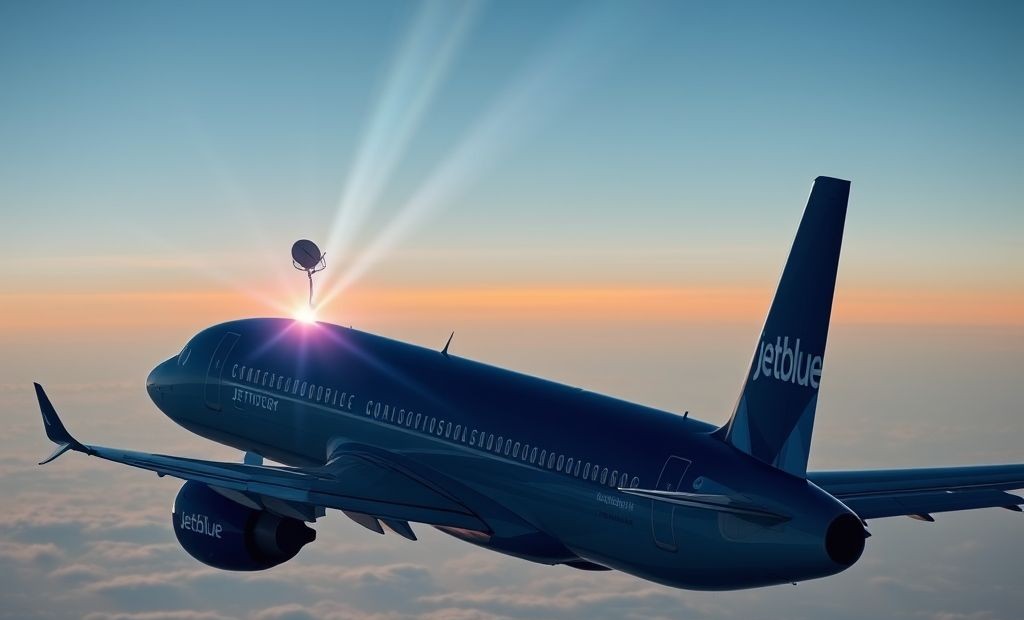JetBlue Partners with Amazon’s Project Kuiper for Free Wi-Fi
JetBlue is teaming up with Amazon’s Project Kuiper to bring free high-speed internet to its passengers. Notably this collaboration marks a significant step in enhancing the in-flight experience. As a result travelers can stay connected without incurring extra costs.
The Power of Project Kuiper
- First Airline Partner
JetBlue has become the first airline to sign on with Amazon’s Project Kuiper marking a milestone for in-flight satellite internet. Investors.com
- Launch Timeline
The rollout is slated to begin in 2027 with installations on select aircraft initially estimates suggest around 25% of its fleet roughly 70 planes will be outfitted.
- Fly-Fi Upgrade
This will enhance JetBlue’s existing Fly-Fi free onboard Wi-Fi offering. Moreover the new system promises higher speeds and reduced latency thanks to LEO satellite technology.
- Hybrid Connectivity Strategy
JetBlue plans to adopt a multi-orbit strategy blending its current GEO satellite system via Viasat with Kuiper’s LEO network for a more robust in-flight internet experience.
Superior Performance
Kuiper’s LEO satellites orbit at 367–391 miles 590–630 km significantly closer than GEO satellites (22,000+ miles). Consequently this results in lower latency and smoother streaming and productivity online.
Strong Speeds
The aviation-grade terminal featuring a full-duplex Ka-band phased-array antenna can support speeds up to 1 Gbps to a single device. Consequently it enables seamless streaming or video calls on board.
Project Kuiper’s Ambitious Scope
- Established in 2019 with FCC approval to launch 3,236 satellites half of which must be operational by mid-2026.
- As of mid-2025 over 100 satellites are already in orbit with multiple launches underway and planned.
Strategic Aviation Partnership
Amazon also signed an MoU with Airbus earlier in 2025 to integrate Kuiper’s connectivity solutions into new and retrofit aircraft via the HBCplus program. Consequently this positions Kuiper for wider adoption across the aviation industry.
Competitive Landscape
While Amazon is just entering the aviation space SpaceX’s Starlink already provides in-flight internet for several carriers including United and Hawaiian. Meanwhile Kuiper’s strong entry via JetBlue sets the stage for fierce competition.

Competitors Feeling the Pressure
JetBlue’s announcement underscores growing competitive pressure. Consequently as JetBlue races ahead with high-speed LEO-based Wi-Fi other airlines are accelerating their own initiatives to avoid being left behind.
- American Airlines: is launching free high-speed Wi-Fi in early 2026 covering around 90% of its fleet using GEO satellites via Viasat and Intelsat spurred in part by competition in the Wi-Fi space.
- As JetBlue said: We do have a lot of our competitors trying to jump on the bandwagon acknowledging the competitive edge Kuiper brings.
A Broader Push for Industry-Wide Advances
- Previously in-flight Wi-Fi was criticized for being slow and costly. However it is now significantly better fast widely available and often free thanks to LEO satellite networks.
- Starlink has already signed on major carriers like United Hawaiian Airlines Air France and Air New Zealand setting a benchmark that Kuiper is now challenging.
Accelerated Innovation & More Affordable Options
JetBlue’s Kuiper adoption is pushing the entire industry to prioritize both technical advancement and cost-efficiency.
This move stimulates innovation from satellite providers and airlines alike more competition means better service at lower cost for passengers.
Furthermore analysts highlight that Kuiper’s presumably affordable aviation terminals under $400 may disrupt industry pricing thereby giving airlines a compelling alternative to more expensive current options.



